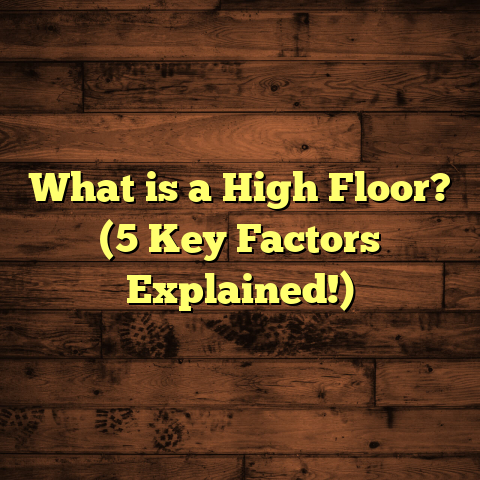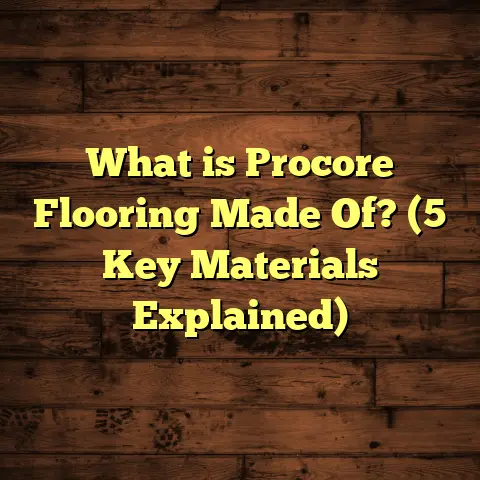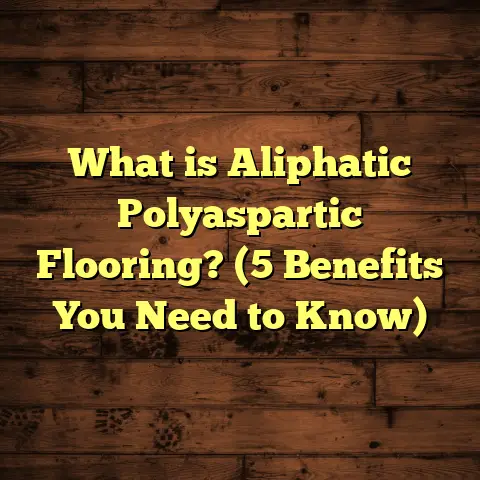What is Solid Parquet Flooring? (5 Key Benefits Explained)
I’ve always been drawn to things that stand out—not just because they’re different, but because they carry stories and character. Flooring is no exception. Over the years, I’ve encountered countless flooring options that vary in style, durability, and installation complexity. Yet, something about solid parquet flooring has consistently caught my eye. It’s not just a floor; it’s a statement piece. There’s a quiet strength in its patterns and a warmth in the wood that feels timeless.
If you’re curious about parquet but aren’t quite sure what makes it special or if it’s right for your home, I’m here to share everything I’ve learned from hands-on experience and deep research. Let’s explore what solid parquet flooring is, why it’s so unique, and the key benefits that make it worth considering.
What is Solid Parquet Flooring?
Solid parquet flooring is often mistaken for simple hardwood planks laid side by side, but it’s so much more intricate than that. The term “parquet” refers specifically to a type of flooring made from small pieces of solid wood arranged in decorative patterns. Unlike traditional plank flooring where long boards are placed in parallel rows, parquetry forms geometric designs such as herringbone, chevron, basket weave, and other complex motifs.
The “solid” part means that each piece of wood used in the parquet is a single, solid block or strip of hardwood—not engineered or layered. This solid construction allows for multiple refinishing cycles and gives the floor excellent durability.
A Closer Look at Parquet Construction
The individual parquet blocks are typically cut from hardwood species like oak, walnut, cherry, maple, or ash. These woods are favored for their hardness and ability to take finishes well. The size of each block varies but commonly falls around 16 cm x 16 cm (6.3 inches x 6.3 inches) for square blocks or strips around 4-6 cm wide for patterns like herringbone.
The thickness ranges between 10 mm and 22 mm (0.4 to 0.87 inches), which is substantial compared to thinner engineered flooring options. This thickness supports sanding and refinishing multiple times over the floor’s life.
The manufacturing process involves carefully selecting timber with low moisture content (about 6-8%) to prevent warping after installation. Each block is precision-cut to ensure tight joints and consistent patterns once laid down.
How Solid Parquet Is Made: From Tree to Floor
- Timber Selection & Drying: The process begins with choosing the right logs. Hardwood species are cut into boards, then dried in controlled environments to reduce moisture uniformly. This drying can take weeks or months depending on thickness.
- Cutting Blocks: Once dried, the boards are sliced into uniform blocks or strips using precision saws. The goal is to maintain consistent sizes so pieces fit perfectly during installation.
- Sanding & Sorting: The blocks are lightly sanded to smooth surfaces and sorted by grain pattern and color for aesthetic harmony in the final layout.
- Optional Pre-finishing: Some manufacturers apply an initial finish (oil or lacquer) before shipping. However, many installers prefer finishing the floor onsite after installation for better control over sheen and protection.
- Packaging: Blocks are bundled in kits or pallets arranged to facilitate pattern assembly at the installation site.
Installation Basics
Installing solid parquet requires skill and patience. The subfloor must be perfectly level, clean, and dry—often a challenge in older buildings. The blocks are glued or nailed down one by one according to the chosen pattern.
Patterns like herringbone involve placing rectangular strips at right angles to each other in a zigzag design. Chevron uses angled cuts at the ends of strips to form a continuous V-shape. Basket weave repeats small square blocks in pairs to mimic woven fabric.
Because every piece must align flawlessly, installation usually takes longer than traditional plank floors but results in a stunning visual effect worth the effort.
1. Timeless Beauty That Adds Character
One of the biggest reasons I keep recommending solid parquet flooring is its undeniable aesthetic appeal. There’s something about those intricate wooden patterns that instantly grabs attention—whether it’s underfoot or as part of an entryway or living room centerpiece.
Why Does Parquet Look So Special?
Unlike plain planks that run uniformly along a room’s length or width, parquet patterns create movement and texture. They break up the monotony without overwhelming the space.
The natural grain of hardwood combined with geometric repetition offers a balance between organic warmth and structured design. Plus, different wood species used in patterns can add subtle color variation and contrast.
During an early renovation project, I installed a walnut herringbone parquet floor for a client who wanted a blend of modern style with old-world charm. The result? A floor that guests kept coming back to admire.
Historical Roots of Parquet Flooring
Parquet floors have been around since at least the 17th century when French nobility commissioned them for grand palaces like Versailles. Back then, parquet was chosen over marble because it was warmer underfoot and easier to maintain.
Knowing that you’re walking on a flooring style with centuries of tradition adds depth beyond just its looks—it connects your home to history.
Modern Design Flexibility
Today’s designers use parquet in both classic and contemporary interiors. You can find subtle oak patterns in Scandinavian-inspired homes or bold mixed wood chevron floors in urban lofts.
Some clients even choose exotic woods like teak or mahogany to make their floors pop with richness.
My Take
What I appreciate most about parquet is how it personalizes a space effortlessly. While other floors might date after a few years or tire you visually, good parquet grows on you—its beauty deepening as the wood ages gracefully.
2. Durability and Longevity
When I talk floors with clients, durability always comes up—especially if they have kids, pets, or high foot traffic areas. Solid parquet flooring delivers on this front better than you might expect.
Why Is Parquet So Durable?
The solid hardwood blocks used in parquet have thicknesses ranging from 10 mm to over 20 mm, allowing multiple refinishes over decades without compromising structural integrity.
The Janka hardness test measures wood resistance to denting:
- Oak: ~1360 lbf
- Maple: ~1450 lbf
- Walnut: ~1010 lbf
- Cherry: ~950 lbf
These hardwoods stand up well against scratches and wear compared to softer woods or synthetic floors.
Real-World Longevity Examples
I recently inspected a historic building with original parquet floors installed nearly 100 years ago still intact thanks to periodic maintenance and refinishing cycles.
In residential settings, I often see parquet floors lasting 50 years or more with proper care—far exceeding typical carpet or laminate lifespans which might need replacement every decade or less.
Refinishing Potential
Unlike engineered floors that have thin hardwood layers on top (usually 2-6 mm), solid parquet blocks can be sanded down repeatedly—sometimes 10 times or more depending on thickness.
This ability means you can restore worn floors back to their original glory multiple times instead of replacing them entirely—saving money long-term and preserving unique character.
Impact Resistance & Stability
Because parquet is glued or nailed directly onto subfloors with tight joints, it resists movement better than floating laminate floors—which can sometimes shift or creak.
However, parquet needs stable humidity levels (ideally between 30% and 50%) because solid wood expands slightly with moisture changes. In my experience installing parquet in basements or humid climates, using moisture barriers under the subfloor prevents damage effectively.
3. Improved Indoor Air Quality
You might wonder why flooring affects air quality inside your home—but it really can make a difference.
How Does Parquet Help?
Solid parquet is made from natural wood without synthetic layers or adhesives on the surface that emit volatile organic compounds (VOCs). VOCs come from chemical products like certain vinyls, laminates, or carpets treated with flame retardants and can irritate lungs or trigger allergies.
Parquet floors do not trap dust mites, pet hair, pollen, or allergens like carpeted floors do either—making them ideal for allergy sufferers or asthma patients.
Personal Observations
I had a client with severe dust allergies who switched from wall-to-wall carpeting to solid oak parquet throughout their home. Within weeks they reported fewer allergy flare-ups and improved breathing—proof that flooring choice can impact health more than many realize.
Environmental Benefits
Wood is renewable when sourced responsibly from managed forests certified by organizations like FSC (Forest Stewardship Council). Choosing parquet from such sources supports sustainable practices versus petrochemical-based flooring materials which contribute more heavily to pollution during production.
4. Versatility in Design
One thing I love about working with parquet is how versatile it is aesthetically and functionally.
Endless Pattern Options
You’re not locked into one look when choosing solid parquet:
- Herringbone: Classic zigzag pattern popular in European architecture.
- Chevron: V-shaped pattern with angled block ends.
- Basket Weave: Blocks arranged in pairs creating woven appearance.
- Point de Hongrie: Similar to herringbone but with longer blocks.
- Versailles Pattern: Complex squares mixed with diagonal strips seen in old chateaus.
Each pattern brings a unique feel—from cozy rustic cabins to sleek urban spaces.
Mixing Wood Species
Parquet lets you mix different wood species within one pattern for contrast:
- Light maple paired with dark walnut.
- Warm cherry combined with golden oak.
- Exotic woods like teak interspersed with more common hardwoods for pops of color.
This kind of customization is tough with standard plank floors but achievable here due to small block sizes.
Practical Design Benefits
Since parquet pieces are small and precisely cut:
- They fit irregular room shapes better.
- They accommodate uneven walls without large gaps.
- They allow creative borders or medallions unlike straightforward plank layouts.
One client wanted a circular parquet medallion inset in the foyer surrounded by regular oak planks—a stunning focal point we created using custom-cut pieces.
5. Adds Value to Your Home
From my years working alongside homeowners and real estate agents, I’ve seen how floors influence property value more than most realize.
Market Data Supporting Hardwood Floors’ Value
According to studies from the National Wood Flooring Association (NWFA) and real estate firms:
- Homes with hardwood floors—including solid parquet—sell faster than those without.
- Hardwood floors can increase resale value by 2–5% on average compared to carpeted homes.
- Buyers perceive hardwood as a quality upgrade worth paying extra for due to durability and style longevity.
Why Do Buyers Love Parquet?
The craftsmanship appeal is huge here; unlike mass-produced laminate floors seen everywhere, solid parquet feels bespoke and upscale—even if installed modestly.
During an open house for one project I worked on recently, potential buyers lingered in rooms with walnut herringbone parquet floors commenting on how much more “inviting” those spaces felt versus similar homes nearby without such flooring.
Personal Experience With Property Sales
I had clients who installed solid oak parquet before listing their home receive multiple offers above asking price—largely attributed to flooring’s visual impact in photos and walk-throughs.
It’s an investment that pays off not just aesthetically but financially if you plan on selling down the line.
My Personal Story With Solid Parquet Floors
Let me share one story that really shaped my appreciation for solid parquet flooring:
Early in my career, I was hired for a restoration project on a Victorian-era home where the owner wanted authentic parquet floors similar to those originally installed but long removed over time.
The challenges were many—the uneven subfloor required extensive leveling; some walls weren’t square; the client wanted an intricate Versailles pattern mixing oak and cherry blocks; plus it had to be done within budget constraints.
It was tough work but incredibly rewarding when we finished after weeks of careful measuring and fitting every single block by hand.
That experience taught me how much patience and skill goes into fine woodworking on floors—and how that effort translates into something timeless you don’t just walk on but live with every day.
Technical Specifications & Manufacturing Details Expanded
Let’s get into some deeper technical specifics about solid parquet flooring:
| Technical Detail | Description |
|---|---|
| Thickness | Commonly ranges from 10 mm (0.4″) up to 22 mm (0.87″) |
| Block Sizes | Square blocks ~16×16 cm; strips vary from 4–6 cm wide |
| Moisture Content | Controlled drying reduces moisture to 6–8% |
| Wood Species | Oak, Walnut, Maple, Cherry, Ash most common |
| Janka Hardness | Varies: Oak (1360), Maple (1450), Walnut (1010), Cherry (950) lbf |
| Finish Types | Oil-based finishes penetrate deeply; polyurethane lacquers form protective surface layer |
| Installation Methods | Glue-down preferred for stability; nail-down sometimes used on wooden subfloors |
| Life Expectancy | With maintenance, 50+ years typical |
| Sound Insulation | Solid wood transmits sound; underlayments recommended for noise reduction |
Manufacturing Process Detailed Steps:
- Selection of Logs: High-quality hardwood logs are selected based on density and grain characteristics.
- Kiln Drying: Boards are dried slowly in kilns over weeks at controlled temperature/humidity.
- Sawing Blocks: Precision saws cut evenly sized blocks or strips.
- Planing & Sanding: Blocks planed flat; edges machined for tight joints.
- Sorting & Grading: Blocks sorted for color uniformity or mixed species patterns.
- Packaging: Blocks bundled ready for shipment or onsite finishing/pre-finishing applied as per customer preference.
Installation Challenges & Best Practices
Although I love solid parquet for its beauty and durability, installing it isn’t without challenges:
- Subfloor Prep: Uneven subfloors cause alignment issues; must be leveled within ±3 mm over 2 meters.
- Moisture Checks: High subfloor moisture leads to cupping or gaps; moisture barriers often essential.
- Pattern Layout: Accurate layout planning avoids awkward cuts near walls; dry lay helps visualize.
- Adhesive Choice: Proper glue selection critical based on subfloor type (concrete vs plywood).
- Expansion Gaps: Leave perimeter expansion gaps (~10 mm) for natural wood movement.
In one tricky basement renovation, we had to install a moisture barrier beneath glued-down oak herringbone blocks because concrete slab moisture was borderline high—preventing future warping was worth extra effort upfront.
Labor Time & Cost Considerations
Parquet installation takes more labor hours than planks due to meticulous block placement:
- Average labor time: 1–2 days per 100 sq ft depending on pattern complexity.
- Installation costs often range $6–$12 per sq ft.
- Material costs depend on wood species: $8–$20 per sq ft common.
- Finishing onsite adds $2–$5 per sq ft depending on finish type chosen.
Using FloorTally for Cost Estimation
Managing all these variables can be overwhelming when budgeting projects. Tools like FloorTally have helped me organize estimates easily by compiling local material prices, labor rates, waste factors, and finish costs into one clear summary.
This way I can quickly adjust scenarios—say switching from oak to walnut or changing patterns—and give clients realistic cost projections without endless back-and-forth quotes from suppliers or subcontractors.
Maintenance Tips To Keep Parquet Floors Stunning
Taking care of solid parquet flooring isn’t complicated but requires consistent attention:
- Use soft felt pads under furniture legs.
- Sweep/vacuum regularly using brush attachments suitable for hardwood.
- Mop only with lightly damp cloths; avoid standing water.
- Clean spills immediately.
- Avoid harsh chemicals; use pH-neutral wood cleaners.
- Maintain indoor humidity between 30–50% year-round using humidifiers/dehumidifiers as needed.
- Refinish every 7–10 years depending on wear patterns.
For families with pets or kids, frequent sweeping is key since dirt/grit can scratch wood surfaces over time.
Case Study: Transforming an Urban Loft With Parquet Flooring
A few years ago I worked on an urban loft renovation where the client wanted something modern yet classic underfoot—no carpet, no plain planks. We chose white oak solid herringbone parquet with matte oil finish throughout living areas totaling about 1200 sq ft.
Challenges included uneven concrete subfloor and tight installation windows due to other contractors’ schedules.
Using FloorTally helped me budget materials precisely—including waste factor around 7% since there were many corners—and schedule labor efficiently.
The final result was stunning—the geometric floor pattern complemented exposed brick walls while adding warmth contrasting sleek metal furnishings inside the loft.
Visitors kept commenting how the floor tied everything together elegantly without overpowering the industrial vibe.
Client feedback months later: “Best decision we made—the floor feels alive.”
This project reaffirmed how parquet can suit both historic homes and contemporary spaces beautifully.
If you’re still wondering whether solid parquet flooring fits your style or budget, consider these questions I often ask my clients:
- Do you want a floor that will last decades rather than needing replacement soon?
- How important is unique character and design flexibility?
- Are you prepared for professional installation involving precise work?
- Do you have any allergies that could benefit from natural wood surfaces?
- Is your home environment controlled enough (humidity-wise) for solid wood?
If you answered yes to any of these, solid parquet deserves serious thought.
To sum up—oh wait! Scratch that—I’ll say this instead:
Solid parquet flooring blends centuries-old craftsmanship with practical benefits today’s homeowners crave: durability, timeless style, healthier indoor air quality, design versatility, and strong property value gains.
It’s not just about covering your floor—it’s about creating an environment where each step feels connected to nature, artistry, and comfort.
If you want help exploring patterns or calculating costs tailored to your project specifics using tools like FloorTally—or simply want my personal advice based on hands-on experience—just reach out.
I’m always happy sharing what I know about this beautiful flooring option.
Would you like me to walk you through specific pattern options? Or maybe tips on pairing parquet wood species with your interior colors? Just ask!





